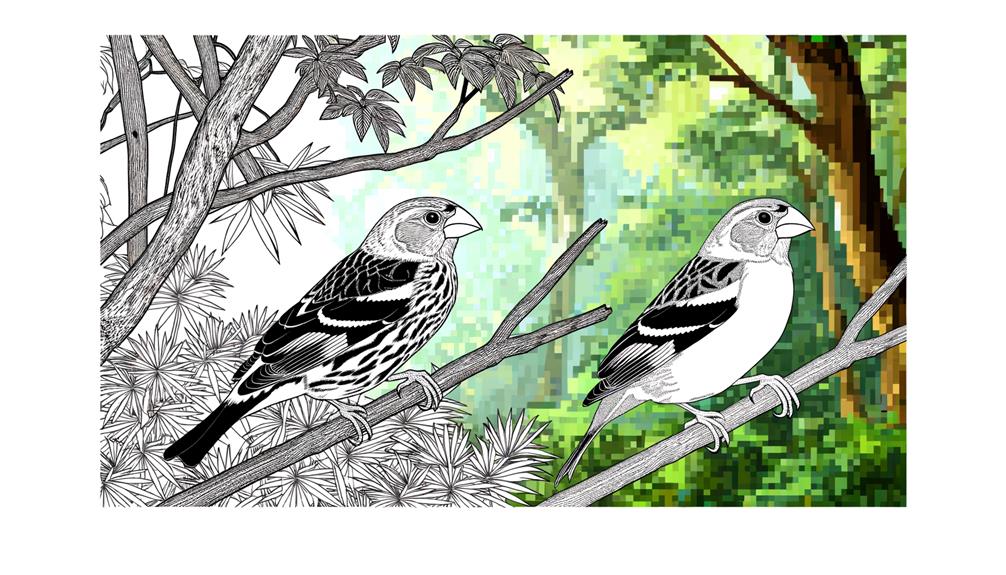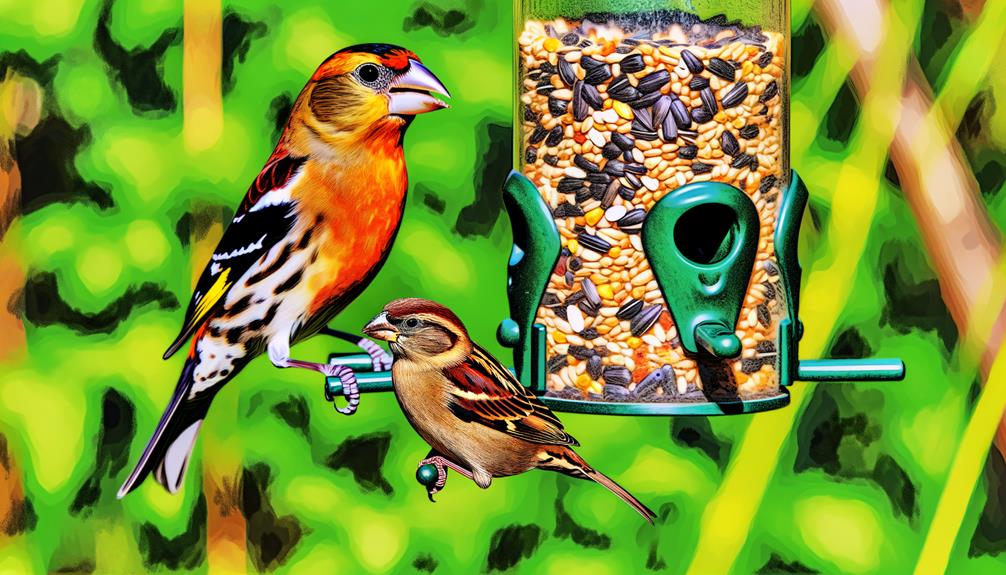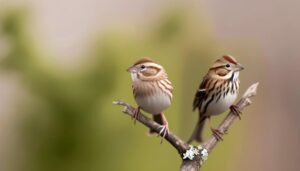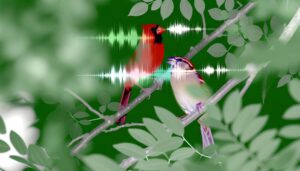3 Key Differences Between Female Grosbeak Vs Sparrow
Female grosbeaks and sparrows differ notably in several traits. Female grosbeaks have a robust physique, thick conical bills, and vibrant plumage, while sparrows are smaller with slender builds and muted feathers.
Grosbeaks produce melodious whistles with broad frequency modulation, contrasting the monotonous, repetitive chirping of sparrows. Grosbeaks crack hard seeds and forage in trees; sparrows' diet includes insects and grains, and they are ground feeders.
Grosbeaks nest in dense foliage, while sparrows use existing cavities. Migratory behaviors also vary; grosbeaks migrate long distances employing geomagnetic and solar navigation.
These details are merely the beginning of their fascinating ecological adaptations.

Key Takeaways
- Female grosbeak is larger and more robust compared to the smaller and slender female sparrow.
- Female grosbeak has a thicker, triangular-shaped beak, while the female sparrow's beak is thinner and more delicate.
- Grosbeak females display more vibrant and colorful plumage, whereas sparrow females have muted and subtle feather colors.
- Female grosbeaks are more vocal with louder calls, in contrast to the quieter, softer calls of female sparrows.
- Grosbeaks nest in dense foliage using twigs and grass, while sparrows often use existing cavities or human-made structures for nesting.
Physical Appearance

The female grosbeak exhibits a robust physique with a thick, conical bill, whereas the female sparrow displays a more slender build with a finer, pointed beak.
The grosbeak's plumage features a mix of browns and streaks, providing effective camouflage in dense foliage. In contrast, the female sparrow's feathers are generally more uniform in color, often with subtle hues of brown and gray, aiding in blending into open fields.
The grosbeak's powerful bill is adapted for cracking hard seeds, demonstrating a specialized feeding adaptation. Meanwhile, the sparrow's bill is more suited for foraging small insects and seeds.
Both species showcase evolutionary adaptations tailored to their ecological niches, emphasizing the remarkable diversity in avian morphology and function.
Song and Calls
In contrasting their vocalizations, one observes that the female grosbeak produces a series of melodious whistles, whereas the female sparrow emits a more monotonous and repetitive chirping. The grosbeak's song features complex, varied tonal modulations that indicate a sophisticated neural control of syrinx muscles. Alternatively, the sparrow's calls are characterized by consistent pitch and rhythm, reflecting simpler vocal cord mechanics.
To understand these differences better, consider:
- Frequency Range: Female grosbeaks exhibit broader frequency modulation than female sparrows.
- Song Structure: Grosbeaks' song sequences are more intricate and variable compared to sparrows' repetitive patterns.
- Behavioral Context: Grosbeaks use their calls for nuanced communication, while sparrows primarily utilize theirs for territory marking and alert signals.
These distinctions highlight the unique evolutionary adaptations in avian vocalizations.
Feeding Habits

The feeding habits of female grosbeaks and sparrows exhibit distinct dietary preferences and behaviors. Female grosbeaks primarily consume seeds and fruits, using their robust beaks to crack hard shells, while sparrows exhibit a more varied diet that includes insects, grains, and seeds.
Observations indicate that grosbeaks often forage in trees and shrubs, whereas sparrows are typically ground feeders, reflecting their ecological niches.
Diet Preferences Comparison
Female grosbeaks and sparrows exhibit distinct feeding habits, influenced by their morphological adaptations and ecological niches. Female grosbeaks primarily consume seeds, utilizing their robust, conical beaks to crack open hard shells. Their diet includes:
- Sunflower seeds – Rich in fats and proteins.
- Tree buds and fruits – Providing essential vitamins.
- Insects – Particularly during breeding season for protein.
Sparrows, on the other hand, exhibit more generalized feeding patterns. Their diet includes a mix of seeds, grains, and small insects, aided by their slender, pointed beaks. They often forage on the ground, exploiting easily accessible food sources.
The dietary distinctions between these species are shaped by evolutionary pressures and habitat preferences, ensuring their survival and reproductive success within their respective ecological niches.
Feeding Behavior Differences
Observational data reveal distinct feeding behaviors between female grosbeaks and sparrows, with grosbeaks employing their powerful beaks to manipulate and consume hard seeds, while sparrows exhibit a more opportunistic foraging strategy, often scavenging for various food items on the ground.
Grosbeaks' robust beaks allow them to crack open tough seed shells, maximizing nutrient intake. They often perch on branches, meticulously husking seeds. In contrast, sparrows display generalized feeding habits, sifting through leaf litter and pecking at small insects, grains, and discarded food. This opportunistic foraging allows sparrows to adapt to diverse habitats, from urban environments to rural fields.
These differences underscore the species' evolutionary adaptations, reflecting their respective ecological niches and dietary needs.
Nesting Behaviors
While both female grosbeaks and sparrows exhibit unique nesting behaviors, grosbeaks typically construct their nests in dense foliage using twigs, grass, and rootlets, whereas sparrows opt for a more opportunistic approach, often utilizing existing cavities or human-made structures. Grosbeaks' nests are well-camouflaged, providing protection from predators.
In contrast, sparrows demonstrate remarkable adaptability by nesting in various environments. Key observations include:
- Nest Construction: Grosbeaks meticulously build woven nests, whereas sparrows might line cavities with soft materials.
- Location Selection: Sparrows show flexibility by nesting in eaves, vents, and even birdhouses, unlike grosbeaks.
- Material Use: Grosbeaks use organic materials, while sparrows incorporate synthetic items like string or paper.
These behaviors reflect their ecological adaptations and survival strategies.
Migration Patterns

Both grosbeaks and sparrows exhibit distinct migration patterns, influenced by their species-specific physiological needs and environmental cues.
Female grosbeaks typically engage in long-distance migration, often covering thousands of miles. They rely on geomagnetic fields and solar navigation to reach their wintering grounds in Central and South America.
Conversely, sparrows display more varied migration behaviors. Some species, like the American tree sparrow, are short-distance migrants, moving from northern breeding areas to milder southern regions. Others, such as the house sparrow, are largely sedentary, exhibiting minimal migratory movement.
These differences are driven by factors like food availability and climate. Understanding these patterns provides insights into their survival strategies and responses to environmental changes.
Preferred Habitats
Understanding their migration patterns sheds light on the preferred habitats of female grosbeaks and sparrows, revealing critical ecological preferences and adaptations. Female grosbeaks thrive in deciduous forests, where they find abundant food sources and nesting materials. Their habitats are characterized by dense foliage and varied tree species.
In contrast, female sparrows exhibit a preference for open grasslands and urban areas, adapting to environments with less canopy cover but ample ground resources.
To summarize these habitat preferences:
- Female Grosbeaks: Deciduous forests with dense foliage and tree diversity.
- Female Sparrows: Open grasslands and urban areas with minimal canopy cover.
- Both Species: Specific ecological niches that support their dietary and nesting requirements.
These observations highlight their specialized adaptations to distinct ecological settings.
Interaction With Humans

Human activities have a marked impact on the behaviors and habitats of female grosbeaks and sparrows, influencing their feeding patterns, nesting success, and overall survival.
Urbanization results in habitat fragmentation, forcing these birds to adapt to suburban landscapes. Pesticide use reduces insect populations, an essential food source, thereby altering their foraging behaviors.
In contrast, bird feeders provide supplemental nutrition, often increasing local populations but potentially leading to dependency.
Nest disturbance from human presence or domestic pets can adversely affect reproductive success. Light pollution disrupts circadian rhythms, impacting nocturnal behaviors and predator avoidance strategies.
Conservation efforts, such as creating bird-friendly gardens and minimizing pesticide use, can mitigate some of these negative effects, promoting a harmonious coexistence between humans and avian species.
Conclusion
To sum up, the female grosbeak and sparrow, with their unique physical characteristics and behaviors, paint a vivid picture of avian diversity. The grosbeak's sturdy beak and melodious song contrast sharply with the sparrow's fragile body and simpler chirps.
Their feeding habits, nesting behaviors, and migration patterns offer a fascinating glimpse into the intricacies of bird ecology. Understanding these distinctions enhances our admiration for these winged marvels, as they flutter through diverse habitats, leaving an enduring impression on the natural world.






